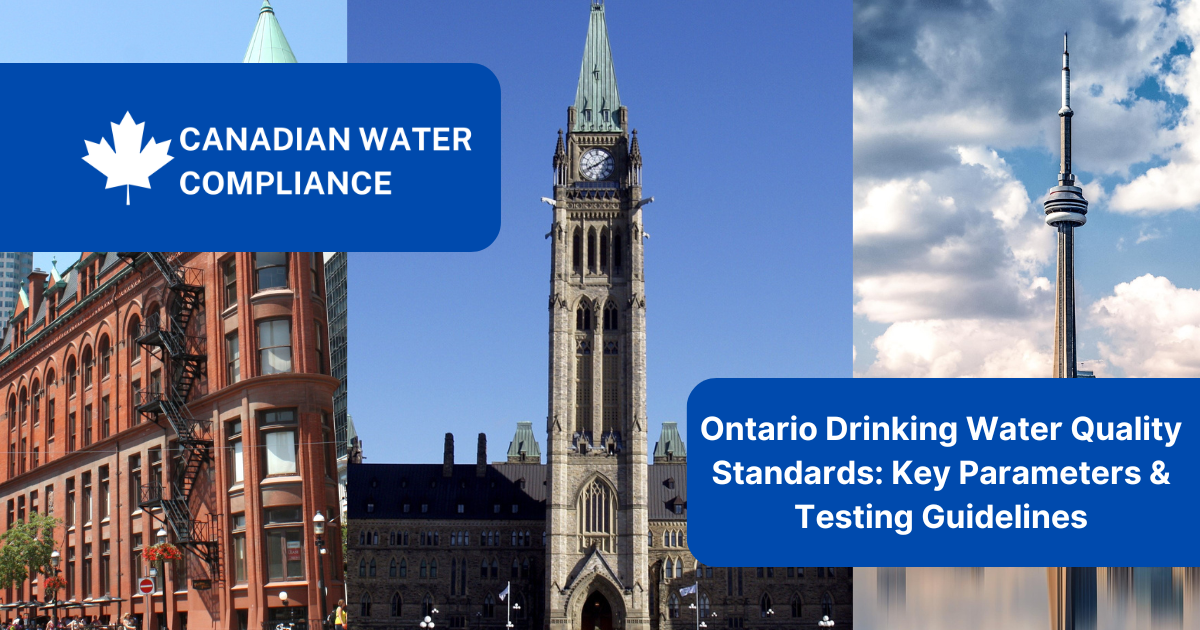
Written By: Canadian Water Compliance | On
Ontario has some of the strictest drinking water quality regulations in Canada, ensuring public water supplies meet health-based and operational guidelines to protect residents. The Ontario Drinking Water Quality Standards (ODWS) set maximum allowable concentrations for various microbiological, chemical, and radiological contaminants in drinking water.
For municipalities, businesses, and private water system owners, compliance with ODWS is critical to ensuring public health and avoiding legal penalties. This guide provides a comprehensive breakdown of ODWS, covering the most important parameters, why they matter, and how to test for them.
The ODWS is a set of legally enforceable standards established under the Safe Drinking Water Act, 2002 and Ontario Regulation 169/03. These standards apply to municipal water systems, private systems serving the public (e.g., schools, hospitals, businesses), and other regulated water supplies.
Each parameter within ODWS has a Maximum Acceptable Concentration (MAC), which is the highest level permitted in drinking water to ensure safety. The standards fall into three main categories:
1️⃣ Microbiological Parameters – Bacteria, viruses, and protozoa that can cause illness.
2️⃣ Chemical & Physical Parameters – Heavy metals, nitrates, and other harmful contaminants.
3️⃣ Radiological Parameters – Naturally occurring radioactive materials that can pose long-term health risks.
Microbiological contamination is the most immediate threat to drinking water safety, as exposure can cause serious gastrointestinal and waterborne illnesses.
Contaminant | Maximum Acceptable Concentration (MAC) | Health Risks |
|---|---|---|
E. coli | 0 CFU/100mL | Severe gastrointestinal illness, kidney failure |
Total Coliforms | 0 CFU/100mL | Indicator of bacterial contamination & biofilm growth |
HPC (Heterotrophic Plate Count) | No health-based limit | Measures overall microbial activity in water |
🔹 E. coli and Total Coliforms must always be absent from treated drinking water. A positive result triggers an immediate boil water advisory or system disinfection.
🔹 HPC (Heterotrophic Plate Count) is not a health risk but is monitored as an indicator of overall water quality.
📌 Testing Requirement:
Municipalities and public water systems must conduct weekly or daily bacterial testing depending on the system size.
Private well owners should test at least three times a year (spring, summer, fall).
Chemical contaminants can enter water sources through natural processes, industrial pollution, or outdated plumbing systems. Long-term exposure to certain chemicals can cause serious health effects, including cancer, organ damage, and developmental disorders.
Contaminant | MAC | Health Concerns | Common Sources |
|---|---|---|---|
Lead | 0.005 mg/L | Neurological damage, developmental delays | Old plumbing, corrosion |
Nitrates/Nitrites | 10 mg/L (nitrate), 1 mg/L (nitrite) | Methemoglobinemia (Blue Baby Syndrome) | Agricultural runoff, fertilizers |
Arsenic | 0.010 mg/L | Cancer, skin lesions | Natural deposits, industrial waste |
Fluoride | 1.5 mg/L | Dental & skeletal fluorosis (at high levels) | Naturally occurring, municipal fluoridation |
Trihalomethanes (THMs) | 0.100 mg/L | Possible carcinogen, linked to liver/kidney damage | Disinfection byproduct (chlorination) |
📌 Testing Requirement:
Municipal water systems must regularly monitor chemical contaminants.
Businesses and property managers should test annually, especially for lead, nitrates, and disinfection byproducts.
Private well owners should test at least once a year for metals and nitrates.
Certain areas in Ontario have higher levels of naturally occurring radioactive materials that can contaminate groundwater. Long-term exposure increases cancer risk.
Contaminant | MAC | Health Risks |
|---|---|---|
Radon | No specific limit, but monitored | Lung cancer risk |
Uranium | 0.02 mg/L | Kidney damage, cancer risk |
Gross Alpha/Beta Particles | 0.5 Bq/L (alpha), 1.0 Bq/L (beta) | Increased cancer risk |
📌 Testing Recommendation:
Groundwater sources in areas with known uranium/radon deposits should be tested.
Testing is not required for all water systems, but recommended for private wells.
Ontario’s Drinking Water Quality Standards apply to:
✅ Municipal Water Treatment Plants – Must meet strict daily testing and treatment requirements.
✅ Businesses & Institutions (Schools, Healthcare, Offices, Restaurants, Hotels) – Must ensure water safety if serving the public.
✅ Apartment Buildings & Condominiums – Water suppliers must test regularly to ensure safety.
✅ Industrial & Commercial Sites – Certain facilities must monitor for chemical contaminants.
✅ Private Well Owners – Not legally required but strongly encouraged to follow ODWS guidelines.
📌 Failure to comply with ODWS can result in fines, legal action, and public health risks.
Ontario’s Drinking Water Quality Standards (ODWS) are essential for protecting public health. Whether you’re a municipal water provider, business owner, or private well user, understanding key parameters like E. coli, lead, nitrates, and disinfection byproducts is crucial.
💡 Need professional water testing? Canadian Water Compliance provides accredited testing services to help businesses, municipalities, and homeowners meet ODWS standards.
📞 Contact us today to schedule your water quality assessment!